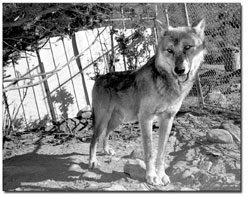|
| ||
| Back on the road to recovery SideStory: Wolves in the San Juans
by Will Sands The Mexican gray wolf has taken a big step back into the region. A recent legal settlement has buoyed efforts to recover the endangered animal, and the wolf will soon have freer range over the Arizona, New Mexico and possibly Colorado backcountry. Once indigenous to the local region, wolves were almost completely eradicated from the American West by the 1950s. The animals were eliminated largely for the benefit of the livestock industry, and most ranchers and farmers remain strongly opposed to the idea of returning the canids to the region. The livestock community has already lost the fight against reintroduction north of Colorado, however. Beginning in 1995, years of in-fighting and legal battles drew to a close and wolf packs were reintroduced to Yellowstone National Park and the mountains of Idaho as “experimental, nonessential populations.” The experiment has worked, and healthy populations containing thousands of wolves are now living in relative harmony with residents and ranchers. The wolf faces a more desperate path south of the Colorado border, where the Mexican wolf reintroduction effort has foundered for more than a decade. Before reintroduction began in 1998, the Fish and Wildlife Service had projected 102 wolves by the end of 2006, including 18 breeding pairs. But a recent count revealed that only 52 Mexican wolves are living in the wilderness of New Mexico and Arizona. Without any change to the reintroduction efforts, conservationists fear the Mexican wolf could experience a second extinction in the wild. “Up until this point, the reintroduction effort has put too much emphasis on managing wolves and not enough emphasis on managing human behavior,” explained Eva Sargent, Defenders of Wildlife’s Southwest program director. “There are ways that wolves and humans can coexist. Thousands of wolves roam the northern party of the country, and the livestock industry is alive and well there.” The U.S. Fish and Wildlife Service took a recent step toward improving the odds for the Mexican gray wolf. Bowing to a lawsuit from a consortium of conservation groups, the agency removed two major roadblocks to the animal’s recovery. The suit was brought by Durango’s Western Environmental Law Center and charged that the agency was spending more time appeasing anti-wolf interests than effectively working toward the recovery of the species.“Reintroduction was actually progressing up until 2003,” said Matt Kenna, the WELC attorney who argued the case. “At that time, the agency adopted policies that became real hindrances and set back the entire effort.” First, the Mexican Gray Wolf Adaptive Management Oversight Committee was created to oversee the reintroduction. Kenna noted that the committee shifted the recovery effort into being less about helping with reintroduction and more about wolf control. Second, the agency created a standard operating procedure whereby three attacks on livestock resulted in the automatic termination of a wolf, regardless of the animal’s place in the pack or importance to the effort. However, the Fish and Wildlife Service and WELC reached a settlement several weeks ago, and both the committee and the three strikes policy have been eliminated. “The government fought the suit at first,” said Kenna. “But since the change in administration, we’ve seen a change in attitude. It turns out the Fish and Wildlife Service didn’t like the rigid three-strikes policy or having decisions made by a committee. In the end, they agreed to withdraw the 2003 rules.” Sargent noted that the Defenders of Wildlife are pleased to see the Fish and Wildlife Service once again taking up responsibility for the recovery effort. “With so few Mexican wolves in the wild, we need to restore the role of science, and this is a good step in that direction,” she said. “Now, the Fish and Wildlife Service must begin to develop a credible recovery plan.” Sargent argued that the Mexican gray wolf needs a scientifically based roadmap to recovery as well as open corridors to roam between regions. Michael Robinson, a conservation advocate at the Center for Biological Diversity, agreed and called for additional areas of introduction on a landscape stretching from Mexico to the Southern Rockies. “More wolves need to be left on the ground and wolves need to be introduced in more areas in the Southwest,” he said. “A new recovery plan is needed to identify more places for Mexican gray wolves to be introduced, including potentially the Grand Canyon, Southern Rockies and Mexico.” For the time being, the Mexican wolf is at least back on the road to recovery, according to Sargent. She also noted that communities, conservationists and government agencies already have a template for successful wolf recovery to follow. “I think the Fish and Wildlife Service has taken a positive step and moved into the next phase of making this reintroduction work,” she said. “If they can successfully reintroduce wolves to the wild in the Northern Rockies, we can definitely do the same in the Southern Rockies.” •
|


